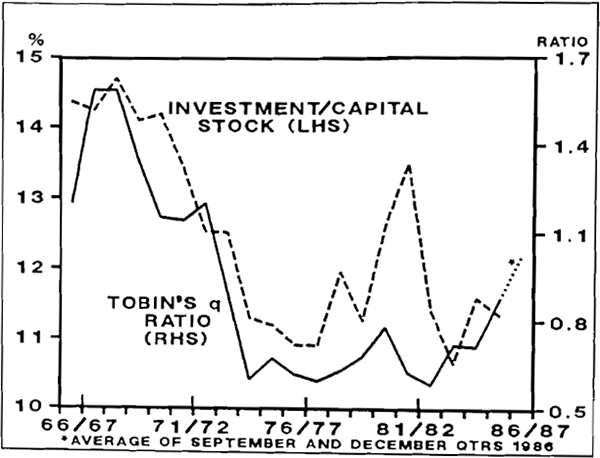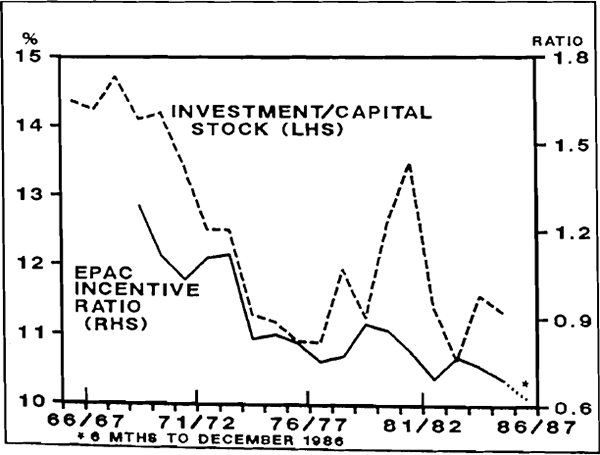RDP 8807: The Cost of Capital: Some Issues 2. The Importance of the Cost of Capital
August 1988
- Download the Paper 803KB
A large number of factors have been identified by the literature as influences on investment. These include:
- the supply of new business opportunities;
- growth of demand relative to capacity;
- movement in product prices relative to factor costs;
- changes in the relative user costs of the various factors of production;
- the activity of governments; and
- business confidence.
This list is far from exhaustive; many of these variables are interrelated and appear to have different weights in business investment decisions at different times. The cost of capital, which is the focus of this paper, is determined by, and also influences, many of these factors.
Ultimately, the decision to invest depends on whether the present value of the expected return from investment, net of direct operating expenses and taxes, exceeds the cost of capital. On marginal investments the two will be equal.
This means that before investment in new capital proceeds, the expected rate of return on that investment should exceed the yield that can be obtained on low risk financial assets by a margin sufficient to cover tax, risk and depreciation. The cost of capital can thus be thought of as the “hurdle” rate of return required on new investment projects. That is, the minimum rate of return a new project must yield to be undertaken profitably.
In Tobin's q theory, investment spending is determined by equating the marginal (stock market) value of capital assets with the marginal cost of those assets. When market participants value existing capital above its replacement cost (q is greater than unity) there should be an incentive for businessmen to invest in new capital. Conversely, there should be a disincentive to invest when q is less than unity. In this approach the market value of capital assets incorporates expectations about future profitability and risk. Thus, according to Tobin the rate of investment should be positively related to q.[1]
The weakness of this approach is its simplicity. It makes no attempt to account for factors such as political uncertainty and speculation that affect the timing as well as the magnitude of investment decisions, or that affect the market value of capital without affecting the decision to invest. Also, marginal q (the ratio of an additional unit of capital spending to replacement cost) is not directly observable. Thus equality between average and marginal q is implicitly assumed.[2]
Figure 2.1 shows Tobin's q, together with business fixed investment as a proportion of the capital stock. Allowing for a lag of at least a year between the emergence of the incentive to invest and the actual installation of capital, the graph suggests a fairly close relationship along the lines predicted by Tobin. Taking a slightly different approach, McKibbin and Siegloff (1987) suggest that q theory explains a statistically significant part of investment. In their study, approximately 10 per cent of investment is explained by q theory.

The period since 1982, however, does not apear to fit well with the general picture; in that period, q indicates a strong rise in the incentive to invest while actual investment, as a proportion of the private sector's capital stock, has been falling.
Another measure, which is sometimes also referred to as a q ratio is the EPAC incentive ratio. This ratio compares the expected rate of return on new capital with the rate of return required to meet depreciation and the opportunity cost of funds (that is, the rate of return on alternative low risk assets). Figure 2.2 shows the ratio of investment to capital against the EPAC variable. Again, the relationship is predicted and quite credible. In particular, the EPAC measure explains the lacklustre performance of investment over the past two years better than does Tobin's q, although the latter provides a better explanation of the early to mid 1970s.

In concept, this measure is quite similar to Tobin's q since it incorporates many of the same factors. In practice, the two are quite different, largely as a result of the data used. In particular, the EPAC measure uses a long-run measure of expected returns based on the AMPS model.[3] Tobin's q, on the other hand, is based on data from a sample of 50–60 companies listed on the Sydney Stock Exchange.
The difference between these two measures during the past few years highlights the need to take into account both debt and equity costs when measuring the cost of capital. Both of these measures have weaknesses. Tobin's q reflects expected profitability relative to the cost of equity funded investment, while the EPAC measure does not take into account the fact that investment can at times be funded more cheaply using equity finance than debt finance. The next section takes a closer look at the divergent movements in the cost of debt and equity. Sections 4 and 5 explore a more comprehensive measure of the cost of capital.